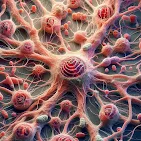Research on the neurobiology of SUDs has traditionally focused on neurons. However, recent studies have highlighted the importance of **glial cells** in these disorders and the fact that alcohol and other drugs (AODs) affect their dynamics. AODs have direct or indirect actions on glial cells, promoting a reactive glial state that significantly modifies the functions of these cells with substantial changes in morphology and gene expression.
Glia and SUDs
Recent studies have shown that glia is involved in the cellular, molecular, and synaptic changes that occur in neurons after drug exposure and influence drug-associated behaviors. The interaction between neurons and glia can amplify the harmful effects of AODs on the brain and is likely to contribute to the development of addiction (Saba, 2023).
Currently, the neuroinflammatory hypothesis is widely accepted as a determinant of the adverse brain effects of AODs, which modulate the response of neuroimmune cells and disrupt the release of pro- and anti-inflammatory cytokines and chemokines(Saba, 2023). This modulation occurs either indirectly by acting on various neurotransmitter systems that then affect the glial response, or directly by activating specific receptors on glial cells that mediate inflammatory responses upon activation(Saba, 2023).
The effects of AODs on glial cells play a fundamental role in the development of the compulsive behaviors underlying drug use and in the deleterious effects of drugs on the brain. Therefore, pharmacological mechanisms involving glia and central immune signaling are now being targeted for the development of therapeutic approaches in the prediction and treatment of SUDs (Saba, 2023).
Microglia and SUDs
Implications of Microglia in SUDs
Saba (2023) gives us some implications of microglia in SUDs:
- .Microglia are the resident immune cells of the central nervous system and are involved in neural development and in the pruning that is necessary for normal brain function. In the adult CNS, microglia perform surveillance functions to maintain homeostasis and are the first to respond to tissue damage and perturbations.
- In response to brain injury, microglia undergo changes in their molecular profile, gene expression, morphology, and ultrastructure. These changes are dependent on the type and intensity of brain injury and vary with time.
- Reactive microglia have previously been classified into two phenotypes: a pro-inflammatory phenotype, which produces inflammatory mediators and exerts deleterious effects, and an anti-inflammatory phenotype, characterized by the secretion of anti-inflammatory cytokines and is involved in reducing the inflammatory response and promoting repair mechanisms.
However, more recent studies have been cautious about the old dichotomous categorization, inconsistent with the broad repertoire of microglial states and functions, and have proposed the coexistence of multiple states. Key variables would result in different microglial functions or properties and drive microglial phenotypic transformations.
Growing evidence suggests that microglia are important in developing and maintaining SUDs and potential addiction. Several drugs have been reported to affect microglial response, particularly alcohol. These drugs increase the number of reactive microglia and neuroinflammatory markers (Saba, 2023). Changes in microglial response and morphology have also been reported in human and animal brains following nicotine and nicotine withdrawal (Saba, 2023). cannabis, and
cocaine (Saba, 2023). and methamphetamine use.
Interestingly, in the adult mouse brain, binge methamphetamine administration promotes an astrocyte-mediated microglial response via glutamate, suggesting an interactive response of glial cells to AODs. This effect of AODs on microglia occurs either directly through specific receptors (toll-like-4 receptors, cannabinoid type 1 and type 2 receptors, α7 nicotinic acetylcholine receptors) expressed on microglia, or indirectly through inflammatory mediators first released in response to AODs from neurons and astrocytes, which then induce microglial inflammatory cascades.
PET Imaging of Microglia in SUDs
Several molecular targets have been investigated for imaging reactive microglia and studying neuroinflammation in vivo. Currently, the standard target for PET imaging of reactive microglial is translocator protein 18 kDa (TSPO), an outer mitochondrial membrane protein. TSPO expression is low in the healthy brain and increases with microglial response after brain injury. This upregulation has been used as a marker of microglial reactivity and neuroinflammation. (Saba, 2023)
















